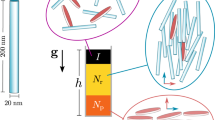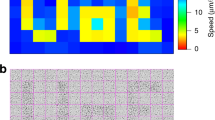Abstract
The slow sedimentation of suspensions of solid particles in a fluid results in complex phenomena that are poorly understood. For a low volume fraction (φ) of particles, long-range hydrodynamic interactions result in surprising spatial correlations1 in the velocity fluctuations; these are reminiscent of turbulence, even though the Reynolds number is very low2,3,4. At higher values of φ, the behaviour of sedimentation remains unclear; the upward back-flow of fluid becomes increasingly important, while collisions and crowding further complicate inter-particle interactions5,6,7,8. Concepts from equilibrium statistical mechanics could in principle be used to describe the fluctuations and thereby provide a unified picture of sedimentation, but one essential ingredient—an effective temperature that provides a mechanism for thermalization—is missing. Here we show that the gravitational energy of fluctuations in particle number can act as an effective temperature. Moreover, we demonstrate that the high-φ behaviour is in fact identical to that at low φ, provided that the suspension viscosity and sedimentation velocity are scaled appropriately, and that the effects of particle packing are included.
This is a preview of subscription content, access via your institution
Access options
Subscribe to this journal
Receive 51 print issues and online access
$199.00 per year
only $3.90 per issue
Buy this article
- Purchase on Springer Link
- Instant access to full article PDF
Prices may be subject to local taxes which are calculated during checkout




Similar content being viewed by others
References
Segrè, P. N., Herbolzheimer, E. & Chaikin, P. M. Long-range correlations in sedimentation. Phys. Rev. Lett. 79, 2574–2577 (1997).
Xue, J.-Z., Herbolzheimer, E., Rutgers, M. A., Russel, W. B. & Chaikin, P. M. Diffusion, dispersion, and settling of hard spheres. Phys. Rev. Lett. 69, 1715–1718 (1992).
Tong, T. & Ackerson, B. J. Analogies between colloidal sedimentation and turbulent convection at high Prandtl numbers. Phys. Rev. E 58, R6931–R6934 (1998).
Levine, A., Ramaswamy, S., Frey, E. & Bruinsma, R. Screened and unscreened phases in sedimenting suspensions. Phys. Rev. Lett. 81, 5944–5947 (1998).
Caflisch, R. E. & Luke, J. H. C. Variance in the sedimentation speed of a suspension. Phys. Fluids 28, 759–760 (1985).
Hinch, E. J. in Disorder and Mixing (eds Guyon, E., Nadal, J.-P. et al. Pomeau, Y.) 153–185 (Kluwer Academic, Dordrecht, 1988).
Koch, D. L. & Shaqfeh, E. S. G. Screening in sedimenting suspensions. J. Fluid Mech. 224, 276–303 (1991).
Brenner, M. P. Screening mechanisms in sedimentation. Phys. Fluids 11, 754–772 (1999).
Adrian, R. J. Particle-imaging techniques for experimental fluid mechanics. Annu. Rev. Fluid Mech. 23, 261–304 (1991).
Cowan, M. L., Page, J. H. & Weitz, D. A. Velocity correlations in fluidized suspensions probed by ultrasonic correlation spectroscopy. Phys. Rev. Lett. 85, 453–456 (2000).
Nicolai, H. & Guazelli, E. Effect of the vessel size on the hydrodynamic diffusion of sedimenting spheres. Phys. Fluids 7, 3–5 (1995).
Nicolai, H., Herzhaft, B., Hinch, E. J., Oger, L. & Guazelli, E. Particle velocity fluctuations and hydrodynamic self-diffusion of sedimenting non-Brownian spheres. Phys. Fluids 7, 12–23 (1995).
Russel, W. B., Saville, D. A. & Schowalter, W. R. Colloidal Dispersions (Cambridge Univ. Press, Cambridge, 1989).
Richardson, J. F. & Zaki, W. N. Sedimentation and fluidization I. Trans. Inst. Chem. Eng. 32, 35–53 (1954).
de Kruif, C. G., van Iersel, E. M. F., Vrij, A. & Russel, W. B. Hard sphere colloidal dispersions: viscosity as a function of shear rate and volume fraction. J. Phys. Chem. 83, 4717–4725 (1985).
Bender, J. W. & Wagner, N. J. Reversible shear thickening in monodisperse and bidisperse colloidal dispersions. J. Rheol. 40, 899–916 (1996).
Acknowledgements
We thank M. Brenner, S. Tee, P. Tong, A. J. C. Ladd, B. J. Ackerson, P. Mucha and A. Levine for discussions. This work was supported by NASA, NSF and the donors of the Petroleum Research Fund, administered by the ACS. Current address of P.N.S. is NASA MSFC, Huntsville, AL 35802 (Phil.Segre@msfc.nasa.gov).
Author information
Authors and Affiliations
Corresponding author
Rights and permissions
About this article
Cite this article
Segrè, P., Liu, F., Umbanhowar, P. et al. An effective gravitational temperature for sedimentation. Nature 409, 594–597 (2001). https://doi.org/10.1038/35054518
Received:
Accepted:
Issue Date:
DOI: https://doi.org/10.1038/35054518
This article is cited by
-
Mixing dynamics of turbidity currents interacting with complex seafloor topography
Environmental Fluid Mechanics (2018)
-
Mixing at a sediment concentration interface in turbulent open channel flow
Environmental Fluid Mechanics (2018)
-
Long-range orientational order in two-dimensional microfluidic dipoles
Nature Physics (2014)
-
A simplified approach to address turbulence modulation in turbidity currents as a response to slope breaks and loss of lateral confinement
Environmental Fluid Mechanics (2014)
-
Size segregation and particle velocity fluctuations in settling concentrated suspensions
Rheologica Acta (2009)
Comments
By submitting a comment you agree to abide by our Terms and Community Guidelines. If you find something abusive or that does not comply with our terms or guidelines please flag it as inappropriate.



